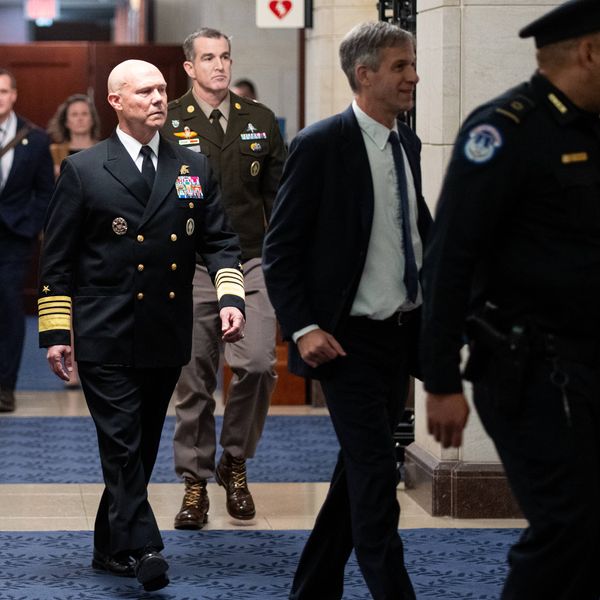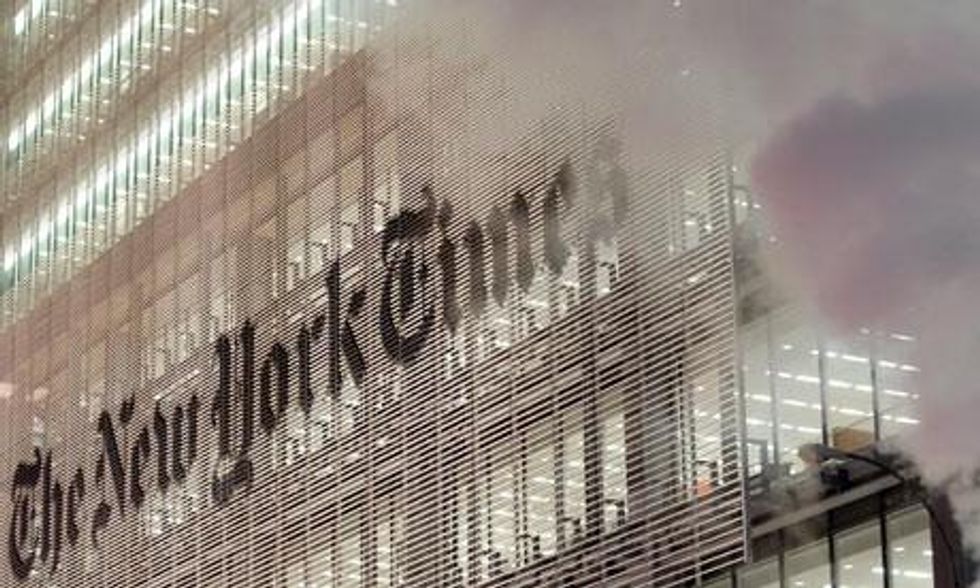The New York Times and the Obama administration have created a disturbing collaborative pattern that asserted itself again on Sunday with the paper's long article purporting to describe the events leading up to the execution by the CIA of US citizen Anwar Awlaki. Time and again, the Obama administration shrouds what it does with complete secrecy, and then uses that secrecy to avoid judicial review of its actions and/or compelled statutory disclosure under the Freedom of Information Act. "Oh, we're so sorry", says the Obama DOJ, "but we cannot have courts deciding if what we did is legal, nor ordering us to disclose information under FOIA, because these programs are so very secret that any disclosure would seriously jeopardize national security".
But then, senior Obama officials run to the New York Times by the dozens, demand (and receive) anonymity, and then spout all sorts of claims about these very same programs that are designed to justify what the US government has done and to glorify President Obama. The New York Times helpfully shields these officials - who are not blowing any whistles, but acting as government spokespeople - from being identified, and then mindlessly regurgitates their assertions as fact. It's standard government stenography, administration press releases masquerading as in-depth news articles.
Sunday's lengthy NYT article on the Awlaki killing by Mark Mazzetti, Charlie Savage and Scott Shane is a classic case of this arrangement. It purports to provide "an account of what led to the Awlaki strike" that is "based on interviews with three dozen current and former legal and counterterrorism officials and outside experts". But what it really does is simply summarize the unverified justifications of the very officials involved in the killing, most of whom are permitted to justify themselves while hiding behind anonymity. It devotes itself with particular fervor to defending the actions of former Obama OLC lawyers David Barron and Marty Lederman, who concocted the theories to authorize due-process-free assassinations of American citizens (those same Democratic lawyers were, needless to say, among the most vocal critics of the Bush administration's War on Terror policies that denied due process and relied on rampant secrecy).
There are many points to make about all of this. To begin with, will the Obama administration - which has persecuted whistleblowers with an unprecedented fervor and frequency - launch a criminal investigation to determine the identity of the "three dozen current and former legal and counterterrorism officials" who spoke to the NYT about the classified Awlaki hit, or, as usual, are such punishments reserved for those who embarrass rather than glorify the president?
Moreover, why can Obama officials run to the NYT after the fact and make all sorts of claims about the mountain of evidence providing Awlaki's guilt, but not have done the same thing in a court of law prior to killing him? As the NYT notes, when the ACLU sued on behalf of Awlaki's father seeking to enjoin Obama from killing his son, the Obama DOJ invoked the "state secrets" privilege, insisting that the evidence against Awlaki was so secret that national security would be jeopardized if disclosed to the court: the very same alleged evidence that Obama officials are now spilling to the NYT. They also deliberately refused to indict him, which would have at least required showing some evidence to a court to justify the accusations against him and would have enabled him to turn himself in and defend himself if inclined to do so.
All of this highlights why it's so odious to prosecute and convict people in a newspaper after you execute them, rather than in a court of law before you end their life. As but one example, the statements about Awlaki from attempted underwear bomber Umar Abdulmutallab on which the NYT heavily relies to assert Awlaki's guilt would have been subjected to intense cross-examination to see if they were simply the results of Abdulmutallab giving the government what they wanted - namely, statements that incriminated someone they wanted to kill - in exchange for favors as part of his plea agreement. It's so basic, though the NYT seems not to have heard, that statements made by accused criminals in exchange for favors as part of a plea bargain are among the most unreliable.
But that kind of critical scrutiny only happens in courtrooms, with due process. By contrast, asserted government evidence is simply mindlessly assumed to be true when it's fed to journalists after the fact without anyone to contradict it or any process available to disprove it. As the ACLU and the Center for Constitutional Rights jointly said yesterday about this NYT story:
"This is the latest in a series of one-sided, selective disclosures that prevent meaningful public debate and legal or even political accountability for the government's killing program, including its use against citizens.
"Government officials have made serious allegations against Anwar al-Aulaqi, but allegations are not evidence, and the whole point of the Constitution's due process clause is that a court must distinguish between the two. If the government has evidence that Al-Aulaqi posed an imminent threat at the time it killed him, it should present that evidence to a court."
Indeed, while the NYT asserts as though it's incontrovertible that he was "a senior operative in Al Qaeda's branch in Yemen", Yemen experts such as Gregory Johnsen have long said the opposite: "We suspect a great deal about Anwar al-Awlaki, but we know very little, precious little when it comes to his operational role" and "Mendelsohn [said]: '(Awlaki) played an important role in a string of attacks in the West'. We just don't know this, we suspect it but don't know it."
Beyond that, the DOJ officials whose conduct is defended by this story have long been important sources to the very NYT reporters writing this article (not just during the Obama years but also the Bush years), so it's a typical case of journalists using anonymity to serve the agendas of their government sources. And it's yet another case where journalistic anonymity is granted not to protect whistleblowers from recriminations by the powerful, but to protect government officials from accountability so they can justify government conduct. And, finally, Marcy Wheeler details several extremely dubious claims that were passed off as fact by this NYT article: here and here.
But I want to focus on one key point. What prompted my opposition from the start to the attempted killing of Awlaki was that it was very clear he was being targeted because of his anti-American sermons that were resonating among English-speaking Muslim youth (sermons which, whatever you think of them, are protected by the First Amendment), and not because he was a Terrorist operative. In other words, the US government was trying to murder one of its own citizens as punishment for his political and religious views that were critical of the government's policies, and not because of any actual crimes or warfare.
The NYT addresses this concern directly with a long, convoluted explanation that the Obama administration refrained from targeting Awlaki when they thought he was only a "dangerous propagandist", and decided to kill him only once they obtained proof that he was an actual Terrorist operative. The NYT says that this proof was obtained in "late January 2010" when Abdulmutallab cooperated with authorities and claimed Awlaki participated in his plot. In order to validate this explanation, the NYT claims that a December, 2009 drone strike in Yemen that was widely reported at the time to have targeted Awlaki - and which media outlets falsely reported killed him - was actually targeting others, and that Awlaki would merely have been oh-so-coincidental (and perfectly legal) "collateral damage". Here is the NYT's effort to insist that the Obama administration targeted Awlaki for death only once it obtained evidence in late January, 2010 that he was more than a mere propagandist:
"[Awlaki's] eloquent, English-language exhortations to jihad turned up repeatedly on the computers of young plotters of violence arrested in Britain, Canada and the United States."By 2008, said Philip Mudd, then a top F.B.I. counterterrorism official, Mr. Awlaki 'was cropping up as a radicalizer - not in just a few investigations, but in what seemed to be every investigation.'
"In November 2009, when Maj. Nidal Malik Hasan, an Army psychiatrist, was charged with opening fire at Fort Hood in Texas and killing 13 people, Mr. Awlaki finally found the global fame he had long appeared to court. Investigators quickly discovered that the major had exchanged e-mails with Mr. Awlaki, though the cleric's replies had been cautious and noncommittal. But four days after the shootings, the cleric removed any doubt about where he stood.
"'Nidal Hassan is a hero', he wrote on his widely read blog. 'He is a man of conscience who could not bear living the contradiction of being a Muslim and serving in an army that is fighting against his own people.'
"As chilling as the message was, it was still speech protected by the First Amendment. American intelligence agencies intensified their focus on Mr. Awlaki, intercepting communications that showed the cleric's growing clout in Al Qaeda in the Arabian Peninsula, a Yemen-based affiliate of Osama bin Laden's terrorist network.
"On Dec. 24, 2009, in the second American strike in Yemen in eight days, missiles hit a meeting of leaders of the affiliate group. News accounts said one target was Mr. Awlaki, who was falsely reported to have been killed.
"In fact, other top officials of the group were the strike's specific targets, and Mr. Awlaki's death would have been collateral damage - legally defensible as a death incidental to the military aim. As dangerous as Mr. Awlaki seemed, he was proved to be only an inciter; counterterrorism analysts did not yet have incontrovertible evidence that he was, in their language, "operational."
"That would soon change. The next day, a 23-year-old Nigerian named Umar Farouk Abdulmutallab tried and failed to blow up an airliner as it approached Detroit. The would-be underwear bomber told FBI agents that after he went to Yemen and tracked down Mr. Awlaki, his online hero, the cleric had discussed 'martyrdom and jihad' with him, approved him for a suicide mission, helped him prepare a martyrdom video and directed him to detonate his bomb over United States territory, according to court documents.
"In his initial 50-minute interrogation on Dec. 25, 2009, before he stopped speaking for a month, Mr. Abdulmutallab said he had been sent by a terrorist named Abu Tarek, although intelligence agencies quickly found indications that Mr. Awlaki was probably involved. When Mr. Abdulmutallab resumed cooperating with interrogators in late January, an official said, he admitted that 'Abu Tarek' was Mr. Awlaki. With the Nigerian's statements, American officials had witness confirmation that Mr. Awlaki was clearly a direct plotter, no longer just a dangerous propagandist.
"'He had been on the radar all along, but it was Abdulmutallab's testimony that really sealed it in my mind that this guy was dangerous and that we needed to go after him,' said Dennis C. Blair, then director of national intelligence."
So that tortured justification for what the Obama administration did, laundered through the NYT, is clear in its claims: (1) we were legally and constitutionally barred from trying to kill Awlaki when we thought he was just a propagandist; (2) the December, 2009 strike wasn't really targeting him, despite what media outlets reported at the time, because we did not yet have evidence that he was a Terrorist plotter; and (3) we acquired that evidence only in late January, 2010, and only then did we start to target Awlaki for execution. Obviously, those claims are necessary to defend themselves from what would clearly be criminal behavior: trying to kill a US citizen because of the government's dislike for his political and religious speech.
But the first journalist to report on the existence of Obama's kill list and the inclusion of US citizens was the Washington Post's Dana Priest. On January 26, 2010, this is what she wrote:
"As part of the operations [in Yemen], Obama approved a Dec. 24 strike against a compound where a US citizen, Anwar al-Aulaqi, was thought to be meeting with other regional al-Qaeda leaders. Although he was not the focus of the strike and was not killed, he has since been added to a shortlist of US citizens specifically targeted for killing or capture by the JSOC, military officials said . . ."The Obama administration has adopted the same stance. If a US citizen joins al-Qaeda, 'it doesn't really change anything from the standpoint of whether we can target them', a senior administration official said. 'They are then part of the enemy.'
"Both the CIA and the JSOC maintain lists of individuals, called 'High Value Targets' and 'High Value Individuals', whom they seek to kill or capture. The JSOC list includes three Americans, including Aulaqi, whose name was added late last year. As of several months ago, the CIA list included three US citizens, and an intelligence official said that Aulaqi's name has now been added."
According to Priest's reporting back then, the Obama administration was trying to execute Awlaki as early as late 2009 - exactly when the Obama officials who spoke to the NYT admit that they had no evidence that he was anything other than a "propagandist" and this his targeted killing would therefore be unconstitutional and illegal. (That's also a reminder that not only Awlaki, but at least two other still-unknown Americans, have been placed on Obama's kill list). Priest then added that the cause of Awlaki's being placed on the kill list were his "academic" discussions with Nidal Hasan: exactly what the NYT's Obama-official-sources now say are protected free speech that could not be used to legally justify his killing:
"Intelligence officials say the New Mexico-born imam also has been linked to the Army psychiatrist who is accused of killing 12 soldiers and a civilian at Fort Hood, Tex., although his communications with Maj. Nidal M. Hasan were largely academic in nature. Authorities say that Aulaqi is the most important native, English-speaking al-Qaeda figure and that he was in contact with the Nigerian accused of attempting to bomb a US airlner on Christmas Day."
Whatever else is true, there is a serious potential contradiction between the self-justifying claims of the NYT's sources (we waited until late January, 2010 when we acquired evidence of Awlaki's involvement in plots before trying to kill him) and Priest's reporting (the Obama administration began trying to kill Awlaki in 2009, before it had evidence that he had done anything beyond "inspiring" plots with his sermons). The reason this matters so much regardless of your views of Awlaki is obvious, and is certainly on the mind of the NYT's government sources: it would be purely tyrannical, not to mention unconstitutional and criminal (murder), for the US government to try to kill one of its own citizens in order to stop his critical speech.
It's possible that there is a distinction in this reporting between being targeted for killing by JSOC versus the CIA, although the NYT's government sources are clear that any government targeted killing of Awlaki without proof of involvement in terrorist plots - based solely on his sermons - would be legally dubious, at best (indeed, on Democracy Now this morning, the NYT's Scott Shane said: "they had in fact decided they could not target Samir Khan, because he was a propagandist, and not an actual plotter, but he was killed anyway"; when I asked Savage about this, he told me this morning via email that "the exact date that Awlaki went on 'the list' is one of several issues that we dug into at length, and while we were able to mosaic together some answers to some previously outstanding questions this one remains murky"). It's also possible that Priest's reporting was wrong and efforts to kill Awlaki only began in 2010 once the government acquired what it claims is evidence of his involvement in Terrorist plots. It's also possible that the NYT's sources are simply wrong, or worse, when claiming that abundant evidence exists to prove Awlaki's involvement in such plots.
But all of this only underscores why governments of civilized nations don't first execute people without charges or due process and seek after the fact the convict them in a one-sided, non-adversarial process of newspaper leaks; these are exactly the kinds of questions that are resolved by adversarial judicial procedures, precisely the procedures the Obama administration made sure could never take place. It also underscores why responsible media outlets should do more than print these unverified government accusations as truth, especially about a matter as consequential as the government's assassination of its own citizens. That the Obama administration and the New York Times did neither of those things in this case is quite revealing about the function they perform.




